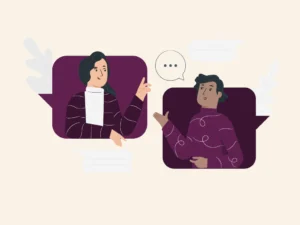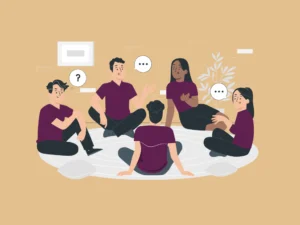At the heart of every effective therapeutic relationship lies a subtle yet powerful force: therapeutic rapport. This connection between therapist and client goes beyond friendliness or professional courtesy—it is the foundation upon which trust, openness, and transformation are built. Whether therapy is short-term or ongoing, whether addressing trauma, anxiety, identity, or relationships, therapeutic rapport influences how deeply a client can engage, disclose, and ultimately heal. This guide explores the nature of therapeutic rapport, how to build and maintain it, and why it plays such a pivotal role in shaping the outcomes of therapy.
Rapport in the Therapeutic Relationship
Rapport in the therapeutic relationship refers to the mutual sense of safety, empathy, and trust between therapist and client. It is the emotional resonance that allows a client to feel seen, heard, and accepted without judgment. Rapport is not built instantly—it evolves over time through consistency, attunement, and responsiveness. A strong therapeutic rapport enables clients to share difficult feelings, explore vulnerabilities, and engage more fully in the therapeutic process. Therapists build this rapport by being fully present, showing genuine interest, and holding space with compassion and curiosity rather than assumption or agenda.
What to Know About Therapeutic Rapport
Therapeutic rapport is both a science and an art. Research in psychotherapy consistently shows that the quality of the therapeutic relationship, including rapport, is one of the strongest predictors of positive outcomes—often more so than the specific modality used. What’s important to know is that rapport doesn’t mean pleasing the client or always agreeing; it’s about creating a respectful, collaborative alliance where honesty and trust thrive. It requires emotional intelligence, cultural humility, and an awareness of the therapist’s own countertransference. Strong rapport creates the container for challenge, change, and deeper therapeutic work.
Why Is Understanding the Past Important in Therapeutic Rapport?
Understanding a client’s past is essential to building meaningful rapport. Clients do not enter therapy as blank slates; they bring histories of attachment, trauma, relationships, and prior experiences with vulnerability and trust. A therapist who seeks to understand the client’s relational and emotional past can better anticipate how the client may respond to emotional closeness, feedback, or perceived authority. For example, a client with a history of betrayal may initially struggle to trust the therapist’s intentions. By gently exploring the client’s past, therapists can adapt their approach, pace, and style to meet the client where they are and build rapport with greater empathy and effectiveness (Voeller, 2023.)
The Role of Empathy in Building Rapport
Empathy is the heartbeat of therapeutic rapport. It involves not just understanding what the client is saying, but deeply sensing what the client is feeling, and reflecting that understanding with care and precision. When a client feels genuinely understood, the therapeutic alliance strengthens, and deeper healing becomes possible. Empathy must be expressed both verbally “That sounds incredibly painful” and non-verbally through tone, eye contact, and attentive body language. It is through these micro-moments of attunement that clients begin to trust the relationship and feel safe enough to explore difficult truths.
Consistency and Reliability as Pillars of Rapport
Clients are often testing the safety of the therapeutic relationship, whether consciously or unconsciously. Consistency and reliability—showing up on time, maintaining boundaries, following through on what is said—serve as silent reinforcements of the therapist’s trustworthiness. These seemingly simple behaviors offer deep reassurance to clients, particularly those with inconsistent or unstable relationship histories. Consistency fosters a secure therapeutic environment, helping clients internalize the idea that not all relationships are conditional or unpredictable. This contributes to the therapeutic rapport by reinforcing safety and dependability.
Cultural Sensitivity and Rapport
Therapeutic rapport cannot be one-size-fits-all. Culture shapes how clients express emotion, interpret help, and engage in relationships. Building rapport with clients from diverse backgrounds requires cultural humility—acknowledging and honoring the client’s lived experience while staying curious and open to learning. Therapists must be mindful of power dynamics, avoid assumptions, and be transparent about their limitations. When clients feel that their identity is respected rather than pathologized, rapport deepens. This sensitivity to cultural, racial, gendered, and other sociocultural contexts is not just ethical; it is relationally essential (Teall, 2024.)
Boundaries and Their Impact on Rapport
While warmth and empathy are crucial, boundaries are equally vital in shaping healthy rapport. Clear boundaries help define the therapeutic container, ensuring that the relationship remains safe, professional, and focused on the client’s needs. Clients often unconsciously test boundaries as a way of seeking safety or replaying past relational dynamics. When therapists hold these boundaries with compassion and firmness, it signals reliability and care. Boundaries are not walls—they are frames that protect the therapeutic space and the rapport within it. Knowing when to gently challenge or hold space can enhance the depth of the connection. (Forchuk, 2024.)
Repairing Ruptures in Therapeutic Rapport
All therapeutic relationships encounter ruptures—misunderstandings, perceived slights, or emotional disconnects. What matters is not the rupture itself but how it is repaired. Therapists who acknowledge the rupture openly, take accountability, and invite the client to share their experience foster a deeper level of trust and authenticity. This repair process can be deeply healing for clients, especially those with histories of unresolved conflict or abandonment. Far from damaging rapport, skillful repair can actually strengthen it, showing clients that relationships can survive misattunement and grow stronger through honest dialogue.
Therapeutic Rapport Across Modalities
Whether a therapist practices CBT, psychodynamic therapy, EMDR, or somatic experiencing, rapport remains central to therapeutic success. While the techniques may differ, all modalities depend on a secure client-therapist relationship to be effective. In structured approaches like CBT, rapport helps the client feel supported in challenging unhelpful thoughts. In deeper approaches like relational psychodynamic therapy, rapport is the very tool through which insight and transformation occur (Gonzalez, 2023.) Regardless of method, no intervention can fully land without the relational glue of rapport
Challenges in Building Therapeutic Rapport
Some clients may struggle to engage in rapport due to mistrust, past trauma, or mental health conditions that affect interpersonal connection. Others may present with guardedness, testing behaviors, or detachment. Building rapport with these clients requires patience, consistency, and sometimes tolerance for silence or resistance (Neequaye, 2023.) Therapists must manage their own feelings of inadequacy or frustration and stay grounded in their intention to offer a safe space. Recognizing that rapport is not always immediate—but can be slowly and respectfully cultivated—helps therapists persist without pressure or defensiveness.
How to Build Rapport With Clients
Building rapport with clients is both a clinical skill and a relational art, one that relies on presence, curiosity, and attunement rather than performance. Establishing this connection early in therapy sets the stage for trust and vulnerability, but rapport continues to deepen with every session. Therapists build rapport by meeting the client’s emotional tone, offering validation, and expressing genuine interest in the client’s inner world—not just their problems. Even the initial moments of a session—how a therapist greets the client, makes eye contact, or remembers a personal detail—can help establish a sense of being valued.
Therapists often use open-ended, non-pathologizing questions to help clients feel safe and empowered. Rather than rushing into a clinical assessment, thoughtful questions like “What would feel helpful to focus on today?” or “What’s been weighing on you most heavily lately?” give clients ownership of their narrative. Empathic reflections such as “That sounds really overwhelming—how have you been managing that?” help deepen emotional connection.
Here are a few examples of rapport-building approaches and questions:
Start with humanity, not pathology:
- “Before we get into anything deep, how’s your week been?”
- “I know therapy can be intimidating—what’s it like for you to be here today?”
Invite the client’s voice into the process:
- “What would make this space feel most supportive for you?”
- “Is there anything you want me to know about how you tend to open up—or not?”
Normalize hesitation and emotion:
- “It’s okay if things feel messy or unclear—that’s part of the process.”
- “If this ever feels too fast or uncomfortable, please tell me. We’ll adjust.”
Use emotional mirroring and attunement:
- “You’ve been carrying so much, and still showing up. That’s incredibly strong.”
- “It sounds like this experience left you feeling really unseen. Is that right?”
These interactions are not scripts—they’re touchpoints for deeper presence. Building rapport doesn’t mean being overly agreeable or withholding boundaries; it means showing up consistently, listening for what is said and unsaid, and offering warmth without condition. With these tools, therapists cultivate a relationship that is not only safe, but also transformative.
Conclusion
Therapeutic rapport is more than just a good feeling between client and therapist—it is the relational foundation upon which healing is built. It requires empathy, attunement, consistency, boundaries, cultural sensitivity, and the willingness to navigate complexity and repair. When rapport is strong, therapy becomes a transformative space where clients can challenge old patterns, take emotional risks, and move toward meaningful change. As therapists, investing in rapport is not a step toward the work—it is the work. When done well, it unlocks the possibility for deep, enduring, and life-affirming growth.
References:
- Voeller, J. (2023). Facilitating Attachment through Therapeutic Rapport and Expressive Arts Therapy with Children Experiencing Complex Trauma: A Literature Review.
- Teall, A. M., Gawlik, K. S., Tucker, S., & Roll, K. (2024). Evidence-Based, Culturally Sensitive, Therapeutic Communication. Evidence-Based Physical Examination: Best Practices for Health and Well-Being Assessment, 53.
- Forchuk, C. (2022). Communication and the therapeutic relationship. Psychiatric and Mental Health Nursing for Canadian Practice.
- Gonzalez, J. (2023). Universality of therapeutic processes across different counseling modalities.
- Neequaye, D. A. (2023). Why rapport seems challenging to define and what to do about the challenge. Collabra: Psychology, 9(1).
Why other mental health professionals love Mentalyc

“It’s really giving me some good confidence … and areas of improvement to see nuances I didn’t see before.”

“There is a lot more feedback and suggestions in it than before … that makes things a little bit easier for me.”

“Using Alliance Genie has really improved my notes … It tells me what I’m doing and gives me an approach of what’s next.”

“Reading transcripts helps me tighten up and come across more the way I want to present myself to clients … it’s helped me improve and keep getting better.”
Licensed Marriage and Family Therapist







